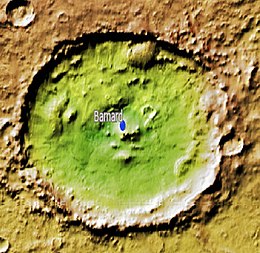
Beer is a crater lying situated within the Margaritifer Sinus quadrangle (MC-19) region of the planet Mars, named in honor of the German astronomer, Wilhelm Beer. It is located at 14.4°S 351.8°E.
Frank Elmore Ross was an American astronomer and physicist. He was born in San Francisco, California and died in Altadena, California. In 1901 he received his doctorate from the University of California. In 1905 he became director of the International Latitude Observatory station at Gaithersburg, Maryland. In 1915 he became a physicist for Eastman Kodak Company at Rochester, New York. He accepted a position at the Yerkes Observatory in 1924 and worked there until his retirement in 1939.

Saheki is a crater on Mars, located in the Iapygia quadrangle at 21.75° S and 286.97° W. It measures approximately 82 kilometers in diameter and was named after Tsuneo Saheki, a Japanese amateur astronomer (1916–1996). The naming was adopted by IAU's Working Group for Planetary System Nomenclature in 2006.
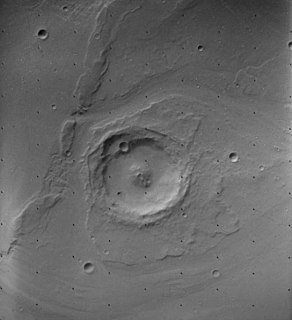
Dromore is a crater on Mars. It measures 14.8 kilometers in diameter and was named after a town in Northern Ireland.
Nipigon is an impact crater on Mars, located in the Arcadia quadrangle just North-East of the volcano Uranius Patera. It measures 9.3 kilometers (5.8 mi) in diameter.

McLaughlin Crater is an old crater in the Oxia Palus quadrangle of Mars, located at 21.9°N 337.63°E. It is 90.92 km (56.50 mi) in diameter and 2.2 km (1.4 mi) deep. The crater was named after Dean B. McLaughlin, an American astronomer (1901-1965). The Mars Reconnaissance Orbiter has found evidence that the water came from beneath the surface between 3.7 billion and 4 billion years ago and remained long enough to make carbonate-related clay minerals found in layers. McLaughlin Crater, one of the deepest craters on Mars, contains Mg-Fe clays and carbonates that probably formed in a groundwater-fed alkaline lake. This type of lake could have had a massive biosphere of microscopic organisms.

Arrhenius is an impact crater in the Eridania quadrangle on Mars at 40.3° S and 237.4° W. and is 129.0 km (80.2 mi) in diameter. Its name, for Svante Arrhenius, was approved in 1973 by the IAU. Evidence of previous glacial activity is evident in images. There also appear to be branched channels just outside the crater.

Focas Crater is an impact crater in the Ismenius Lacus quadrangle of Mars. It is located at 33.9° N and 347.3° W and its name was approved in 1973. Focas Crater is 76.5 km in diameter. It was named after Jean Focas. Pictures reveal many small channels along its rim; some are visible in pictures below from CTX.
Quenisset is an impact crater on Mars, located in the Ismenius Lacus quadrangle at 34.6° N and 319.4° W. It measures 138 kilometer in diameter. Adopted by IAU's Working Group for Planetary System Nomenclature in 1973, the crater was named after French astronomer Ferdinand Quénisset.

Wright is an impact crater in the Phaethontis quadrangle of Mars, located at 58.9°S latitude and 151.0°W longitude. It measures 113.78 km (70.70 mi) in diameter and was named after American astronomer William Hammond Wright (1871–1959). The naming was approved by the IAU in 1973. The Keeler–Trumpler crater pair lies to the south.
Trumpler is a crater in the Phaethontis quadrangle of Mars, located at 61.8°S latitude and 150.8°W longitude. It measures approximately 78 kilometres (48 mi) in diameter and was named after Swiss-American astronomer Robert Julius Trumpler (1886–1956). The name was approved by IAU's Working Group for Planetary System Nomenclature in 1973.

Keeler is an impact crater on Mars, located at 61.0°S latitude and 151.3°W longitude in the Phaethontis quadrangle. It is 95.0 km in diameter and was named after James Edward Keeler, and the name was approved in 1973.

Mie Crater is an impact crater on Mars, located in the Cebrenia quadrangle. The crater was named after German physicist Gustav Mie in 1973.
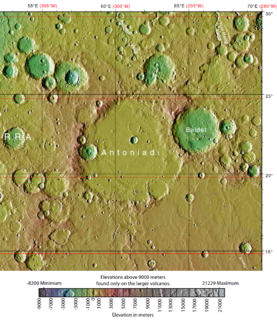
Baldet Crater is an impact crater in the Syrtis Major quadrangle of Mars, located at 23.0°N latitude and 294.6°W longitude. It is 180.0 km in diameter and was named after Fernand Baldet, and the name was approved in 1973 by the International Astronomical Union (IAU) Working Group for Planetary System Nomenclature (WGPSN).
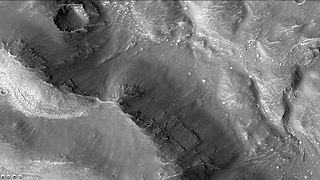
Lampland is an impact crater on Mars, located in the Thaumasia quadrangle at 35.9°S latitude and 79.6°W longitude. It is 79.0 kilometers in diameter and was named after Carl Otto Lampland. The name was approved by IAU's Working Group for Planetary System Nomenclature in 1973.
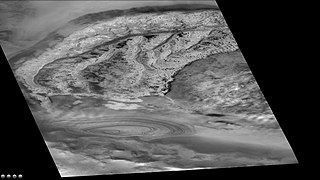
Jeans is an impact crater in the Mare Australe quadrangle of Mars, located at 69.8°S latitude and 205.9°W longitude. It is 80.2 km in diameter and was named after James Hopwood Jeans, and the name was approved in 1973 by the International Astronomical Union (IAU) Working Group for Planetary System Nomenclature (WGPSN). The pictures below show dark areas in which frost is disappearing and the dark ground beneath is being exposed. Layers are also visible—probably from the many cycles of mantle deposition.
